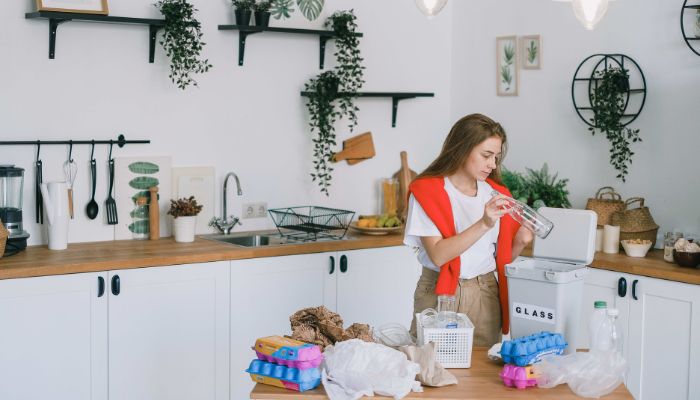Last Updated on April 6, 2023 by Prissila Murillo
The kitchen is the heart of every home. It’s not only where nourishing meals are prepared to fuel bodies and minds, but also where families make memories and dinner party guests gather. However, with the kitchen being such an integral part of our daily lives, waste is inevitable, but luckily we are giving you ideas on how to make your kitchen less wasteful.
1. Less rubbish, please!
Billions of tons of food are wasted around the world every year. Some of it is because of farming and processing, and then more happens during transportation and the retail process – long before it even gets to us!
Although we have no control over the food until it gets to us, we can reduce waste from our very own kitchens when we cook and consume produce. We can use less packaging and try ways to discard waste material without harming the environment.
Use food scraps in creative ways to make tasty dishes. Otherwise, donate them to organic farmers for animal feed or start composting. Organic food, which you would through to the trash, is an excellent fertilizer, and if you don’t have a garden, donate it to local farms or charity organizations.
TIP: Why not begin your own veggie garden? Growing vegetables is one of the best things you can do to reduce waste. You can even start it by re-growing the produce you’ve bought. Your impact on the environment will be reduced, and you’ll use less packaging along with saving more money!
2. Change the way you shop
Every time you drive to the grocery store, you are increasing your carbon footprint. To reduce this litter, plan your meals and shopping lists to reduce trips to the store. Planning your shopping will also make it easier to buy in bulk, which saves money and reduces packaging.
The cost to the environment to produce and transport food to other areas or countries is massive. Buy local and stick to seasonal produce, especially from local farmers. You’ll be lowering your carbon footprint, saving money, and supporting local economies.
3. Packaging – less is More
Less packaging means a lower carbon footprint. Reduce this even further by taking your own bags to the store and selecting products packaged in reusable or recyclable packaging. When you buy cereal or dry goods, choose bags instead of boxes that usually have bags inside anyway.
Buy products like jelly, nut butter, or sauce in glass jars. When the product is finished, upcycle the glass jars into storage containers for items you’ve bought in bulk. This also saves you from spending money on storage containers.
4. Clean your kitchen green
Instead of buying new containers every time, refill dishwashing soap, hand soap, cleaning materials, and laundry detergent. Most of these products are available in bulk or even at refill stations.
Make sure that the products you buy are natural, or even better, make your own non-toxic cleaning agent by combining baking soda and white vinegar. It’s safe, effective, and not bad for the environment.
Watch out for regular kitchen sponges, they can contain heavy metals and other ingredients that are harsh on the environment. Choose eco-friendly sponges instead. If you are still using paper towels, invest in some microfiber cloths; they’re a lot more eco-friendly.
5. Energy-efficient cooking
The less energy is wasted in your kitchen, the lower your carbon footprint is. Use cooking devices that heat up quickly, like gas stoves and induction cookers. If you’re using electricity to cook, turn it off a little bit early – the residual heat will continue to cook the food.
Cook more than one thing at a time in the oven and make one-pot meals where possible. Using a Dutch oven opens a world of possibilities when it comes to making great meals that don’t toss as much energy.
For smaller dishes, use a toaster oven. For meals that take a long time to cook, use a pressure cooker; this could reduce cooking time by as much as 70%. Of course, preparing meals that don’t require cooking, like salads and chilled soups, is the highest efficiency. ADMR offers great options to build your kitchen, go here now if you are ready to make your kitchen dreams come true!
Make Your Kitchen Less Wasteful: Waste not, want not
Even though on average, kitchens produce more waste matter than any other room in the house, it’s also the one room where you can make this ‘trash’ work for you. By following these five steps, you can do your part to reduce waste and help save the environment while reaping the benefits of a more eco-friendly home.
Here are a few hand-picked articles for you to read next:
- Styling 101: The Key to Creating Stylish and Modern Bar Carts
- Affordable Interior Design: How to Create a Chic and Efficient Home Office
- 9 Helpful Tips and Tricks to Beautifully Design Your Own Room
How can I be less wasteful in the kitchen?
1. Have inventory. Take stock of your pantry, refrigerator, and freezer before going to the store to prevent overbuying.
2. Do meal plans
3. Save and eat leftovers when possible
4. Store food appropriately and safely
5. Make compost out of organic trash

